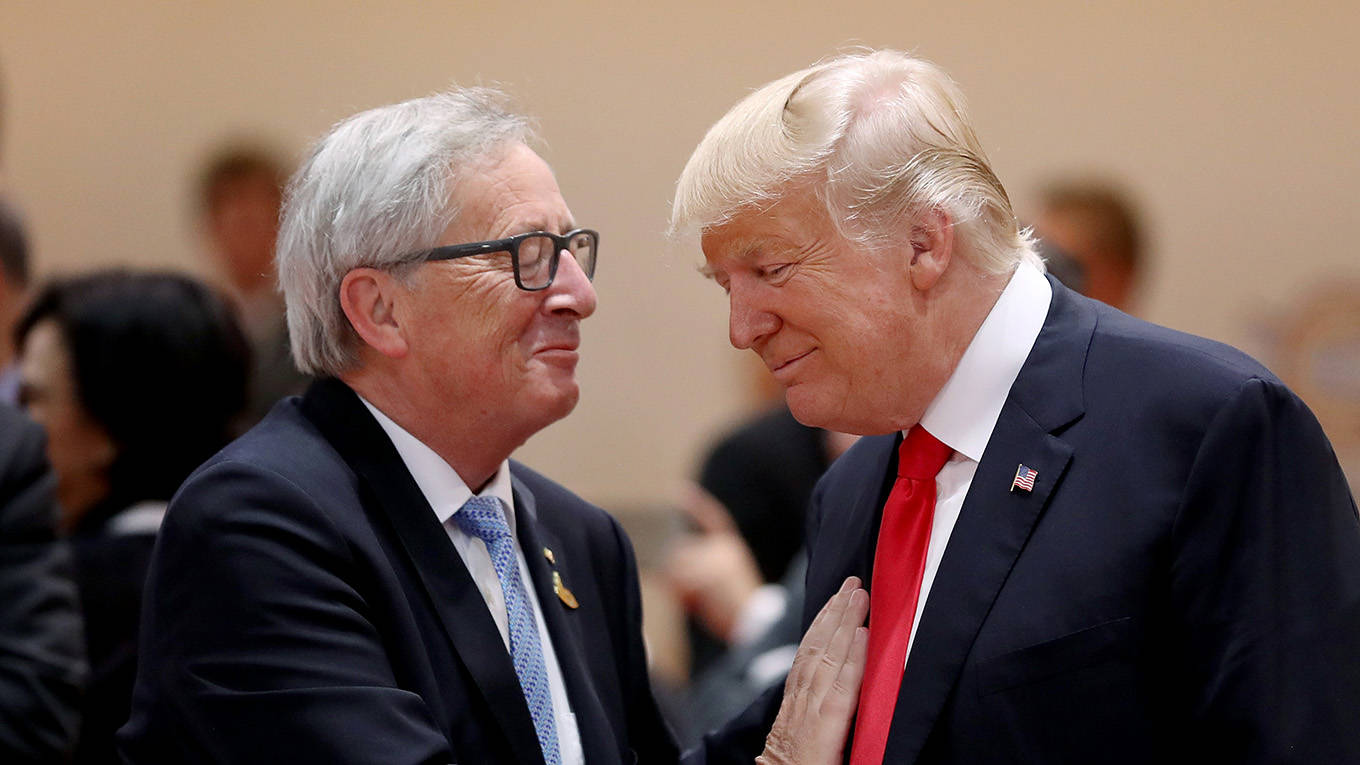 At the core of the recent US-EU trade agreement is the understanding that the two sides will “work together" toward zero tariffs and non-tariff barriers. But the potential for a free-trade deal isn’t the point; the end to the escalation of tit-for-tat tariffs is what matters – and not just to the US and Europe. BRUSSELS – All has gone quiet on the transatlantic trade front, with last month’s agreement between US President Donald Trump and European Commission President Jean-Claude Juncker having dispelled fears of an all-out tariff war. The deal was surprising, but perhaps it shouldn’t have been.
At the core of the recent US-EU trade agreement is the understanding that the two sides will “work together" toward zero tariffs and non-tariff barriers. But the potential for a free-trade deal isn’t the point; the end to the escalation of tit-for-tat tariffs is what matters – and not just to the US and Europe. BRUSSELS – All has gone quiet on the transatlantic trade front, with last month’s agreement between US President Donald Trump and European Commission President Jean-Claude Juncker having dispelled fears of an all-out tariff war. The deal was surprising, but perhaps it shouldn’t have been.
At the core of the agreement concluded by Juncker and Trump was the understanding that the European Union and the United States will “work together toward zero tariffs, zero non-tariff barriers, and zero subsidies on non-auto industrial goods,” with no new trade barriers in the meantime. But the potential for a free-trade agreement isn’t the point; what matters is the end to the escalation of tit-for-tat measures, set in motion by Trump’s decision to impose tariffs on US imports of European steel.
The US president has the power to impose tariffs and other trade barriers unilaterally, in the interest of national security. That is why Trump has been able to launch his own personal trade war, without so much as consulting the US Congress. A full-scale trade agreement, however, would need congressional approval. Given the myriad special interests that such a deal would mobilize, it is highly unlikely that any trade agreement – even one limited to industrial products – will materialize any time soon.
Historically, the US has been able to conclude trade agreements only when a coalition of actors that would benefit from better export opportunities secured more votes than those who were vulnerable to import competition. When trade is considered an economic issue, it is usually possible to assemble such a coalition, because the benefits of trade liberalization outweigh the costs.
But this has often proved more difficult in the US than elsewhere, because trade plays a relatively small role in the US economy. Goods exports may be Trump’s main focus, but the reality is that they account for less than 10% of GDP. Direct employment in exporting industries does not play a significant role in the US labor market.
In Europe, by contrast, exports account for more than 25% of GDP in most countries; in Germany, the figure exceeds 50%. When an economy is so dependent on trade, it becomes much easier to make the case for liberalization, which is why Europe has long been more enthusiastic than the US about a transatlantic free-trade agreement. Negotiations for such an agreement – the Transatlantic Trade and Investment Partnership – stalled during President Barack Obama’s administration.
Beyond the deal itself, Juncker apparently made a personal promise that the EU would buy more US agricultural products. This pledge is both empty and easy to fulfill.
It is empty, because the European Commission has no budget to buy US soybeans or any means to impel EU consumers to do so. It is easy to fulfill, because China has already imposed tariffs on US soybeans in retaliation for US tariffs on its exports, meaning that non-US soybean producers are now likely to shift their exports to the Chinese market, freeing up the EU market for US producers. The main impact of Chinese tariffs on US soybeans will thus be the redirection of global soybean flows.
But China’s role extends beyond soybeans. In fact, it is the trade dynamics with China that explain Trump’s willingness to reach an agreement with Juncker in the first place.
A tariff on imports to the US has a much greater impact if Chinese exporters are the only ones to encounter it. A 25% duty on, say, aircraft engines from China would allow manufacturers elsewhere to gain market share, whereas if everyone had to pay the same tariff, the playing field would be unchanged.
Ensuring that the EU does not face the same tariffs as China is particularly significant, because European suppliers are Chinese exporters’ main competitors in many industries. Given that the EU also competes with the US in the Chinese market, European industry might actually gain (marginally) from a Sino-American trade war. So long as the US and China are battling it out on trade, the transatlantic truce represents a coup for Europe.
The truce is not nearly as good for China. While the country’s leaders have continued to pay lip service to free trade, they have so far proved unwilling to take into account the grievances of both the US and Europe. If China wants allies in its trade war with the US, it will have to revise many domestic regulations and practices that constitute de facto discrimination against foreign competitors.
Thus, the EU-US deal has brought to the fore the real question China’s leaders face: whether to maintain strong government support for domestic industry. While protectionist measures might have been defensible 20 years ago, China’s economy is far more competitive today. Whatever benefit China derives from such measures may well be outweighed by an escalating trade war– especially now that the EU is safe and China will have to face the US alone.
No comments:
Post a Comment